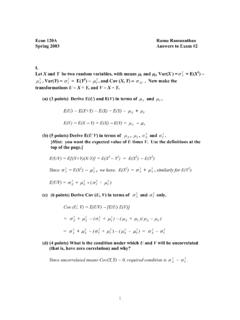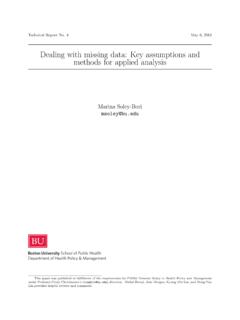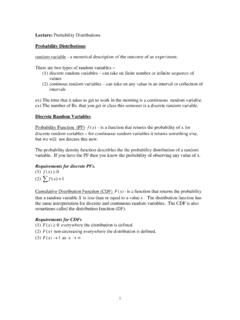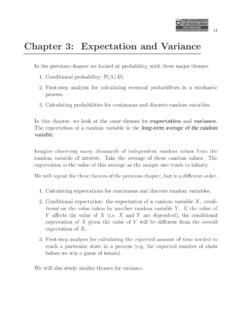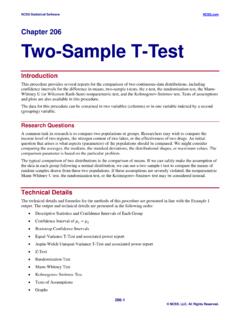Transcription of Chapter two: Precipitation - GitHub Pages
1 Chapter two: Precipitation What is Precipitation ? Precipitation is that part of atmospheric moisture that reaches the earth s surface in different forms The essential requirement of for Precipitation to occur: Moisture in the atmosphere Presence of nuclei around which condensation vapor takes place Dynamic cooling responsible for condensation of water vapor Precipitation product must reach the ground in some form Forms of Precipitation (ppt): Rain: when ppt reaches the surface of the earth as droplets of water (size: ) Snow.
2 When ppt falls in the farm of ice-crystals (hexagonal in shape). It may fall separately or combines to form a flake The density of snow is Drizzle: water droplets of size less than It appears to be floating in the air Hail: it is the precipitating rain in the form of any irregular form of ice with size ranging from 5 to 50 mm Dew: during night when the surface of the objects on earth cools by radiation, the moisture present in the atmosphere condenses on the surface of these objects forming droplets of water What are the types of Precipitation ?
3 Precipitation formation is classified according to the factors responsible for lifting the air mass. The types of Precipitation are: Convective Orographic Cyclonic Convective: lifting of unstable air that is warmer than surrounding air due to uneven surface heating thunder storms spotty and highly variable in intensity Orographic: mountain range barriers cause lifting of the air masses Moist air is forced over mountain barriers by westerly air flow & ppt falls on wind ( , west) side of mountain range while the leeward (eastern) side is warmer and drier Medium to high intensity rainfall continuing for longer duration Cyclonic: a cyclone is a low pressure area surrounded by a larger high pressure area.
4 When a low pressure occurs in an area, especially over large water bodies It causes the air at the low pressure zone to lift The name of this cyclones vary in different places o Tropical cyclone (in India) o Typhoon (South East Asia) o Hurricane (America) Measurement of Precipitation Precipitation is measured as a vertical depth of water that would accumulate on the horizontal surface Units of measurement: mm, cms, inches, feet, etc It is collected & measured by in instrument called rain gauge Instruments that measure Precipitation are.
5 Non-recording cylindrical container type Self recording weighing type float type tipping bucket type Remotely sensed techniques Satellites are in the unique position of being able to provide a broad, spatially consistent, and continuous global sampling of many essential climate variables like Precipitation Radar Weather Radar Measurement of rainfall by weather radar based on principle of that the amount of power returned from raindrop is related to rainfall intensity. The advantages are: Total aerial rainfall can be computed in near real time using online computers at the weather station Can be used for flood forecasting The movement of weather system can be tracked and shown can forecast time of onset.
6 Cession and rainfall intensity Dangerous meteorological phenomena can be detected Example Satellite rainfall estimation of Tigray Regon in the first ten days of June 2003 Example Satellite rainfall estimation of Tigray Regon in the second ten days of July 2003 Ideal Location for a Rain Gauge Station While setting up any rain Gauge station the following points should be noted. site should be on a level ground, , slopping ground, hill tops or hill slopes are not suitable. site should be an open space. distance between the rain gauge and the nearest objects should be twice the height of the objects.
7 Should be away from continuous wind forces. meteorological instruments and the fencing of the site should maintain the step III) above. site should be easily accessible. gauge should be truly vertical. percent of total number of rain gauge stations of any basin should be self-recording. observer must visit the site regularly to ensure its proper readiness for measurement. Location of meteorological stations Precipitation data errors The most significant cause of error in rain data Observations are usually turbulent airflow around the gauge.
8 The dependence of rain gauge catch on wind speed Evaporation from within the measuring cylinder Adhesion of water to funnel, (water then evaporates) Gauge leaks, blockages or overflows in storms Error in observation or transcription Splash in or out Estimating missing data and of Adjustment of records Complete measured Precipitation data are important to many problems in hydrologic analysis and design but there are missing values The causes of missing rainfall data are: The failure of the observer to make the necessary visit to the gage may result in missing data.
9 Vandalism of recording gages is another problem that results in incomplete data records Instrument failure because of mechanical or electrical malfunctioning can result in missing data. Some of the methods of estimating missing rainfall values are Method Method Method method Station-Average Method The station-average method for estimating missing data uses n gages from a region to estimate the missing point rainfall, P, at another gage Where Pi is the catch at gage i. Equation is conceptually simple, but may not be accurate when the total annual catch at any of the n regional gages differ from the annual catch at the point of interest by more than 10%.
10 Example, consider the following data Gage Annual Precipitation (mm) Monthly Precipitation (mm) A 420 26 B 410 31 C 390 23 X 410 ? Ten percent of the annual catch at gage X is 41 mm and the average annual catch at each of the three regional gages is within + or - 41 mm.; therefore, the station-average method can be used. The estimated catch at the gage with the missing monthly Precipitation total is = 1/3(26+31+23) = This method is often used in flat areas with very less rainfall variability Normal-Ratio Method Where wi = the weight for the rainfall depth Pi at gage i.


